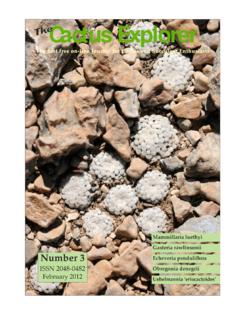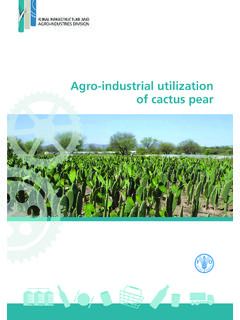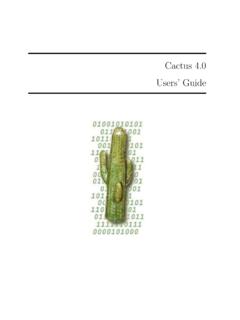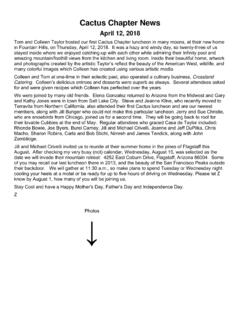Transcription of Succulents and Cactus - BeWaterWise
1 9 Succulents and CactusSouthern California has had a long love affair with Succulents and cacti. And it s no wonder. These plants provide dramatic statements, energizing colors, and exciting forms all for low water and maintenance costs. There is a lot to succulent is a plant that actively stores water in its stem, leaves and roots. All cacti are Succulents , but not all Succulents are cacti. Cactus is distinguished from other Succulents by its spines and hairs. Cactus spines grow in clumps, Succulents do not. These clumps of spines and hairs are the places where new flowers and growth comes from; succu-lents do not bloom or grow in this a general rule: Succulents do better along the coast, where there is little danger of frost and freeze. Cactus does better inland, where there is less danger of moisture and rot. This chapter provides notes on indi-vidual plant care, which includes right type of soil, irrigation, mulches, fertilization, pruning, pests and propagation.
2 Scientifically speaking, not every plant in this chapter is a succulent , but they ve been included here because they are often treated like blue agave, Aloe arborescens, blue chalk fingers (Senecio mandraliscae) and Cotyledon orbiculata (in the background) creates a dynamic landscape that requires little maintenance and California friendly MaintenanCe: your field GuideGeneral Growing TipsBelow are general guidelines for growing Succulents and includes information on soils, irrigation, mulches, fertilization, pruning, pests and propagation. Following this section are specific recommendations for individual drainage is paramount to success. Succulents generally prefer gritty soils and suffer in too much clay. Most favor soils with neutral pH to slightly acidic (6 to 7 pH). Not surprisingly, many Southwestern Succulents , like Dudleya and yucca, grow well in slightly alkaline soils. Succulents generally have low to moderate nutrient needs and dislike nutrient-rich, bacteria dominated Too SandyAdd organic material, the best being wood chips, mulch and compost.
3 Avoid Too ClayeyAdd a combination of wood chips, grit (small gravel) and compost to at least 12". Other effective additives include gravel, mulch, perlite, pumice, and sharp are low-water plants Cactus even more so but they are irrigated differently than other drought-adapted plants. While most have extensive roots, their roots are typically shallow. Succulents and Cactus generally prefer a light watering at more frequent intervals. And, because of their extensive roots, make sure to irrigate beyond the plant s drip line. Importantly, do not irrigate during periods of high : Succulents and Cactus 123 Not all Succulents /cacti need irrigation; however others will need it year round. Generally Succulents do better along the coast and Cactus to No Summer WaterAeonium, Agave, Cotyledon, Dudleya, Escobaria, Ferocactus, Haworthia, Lemaire-ocereus, Nolina, Opuntia, Senecio, YuccaNo Winter WaterAloe, Escobaria, Euphorbia, Ferocactus, Lemaireocereus, OpuntiaMay Need Year Round WaterBeaucarnea, Bulbine, Calandrinia, Crassula, Dadyliron, Echeveria, Epiphyllum, Furcraea, Gasteria, Pachyphytum, Portulacaria, Sedum, SempervivumQuick Guide to Watering Succulents Do not water when foggy, overcast, or when there is high humidity.
4 Water in the morning so the foliage can dry before night. If a succulent looks plump, colorful and juicy, it probably does not need water. If it looks listless, shriveled, or its leaves are bending downward, then it probably needs water. Rainwater is preferable because it is slightly acidic and soft and con-tains no salts and of OverwateringLeaves will show yellowish colors, translucent hues, and/or greyish and stems are swollen and and weed problems are from overwatering is often irreversible; under-watering, generally not. Remedies include shutting off irrigation, pulling back mulches to expose and heat the soil, and pruning to increase sun exposure and California friendly MaintenanCe: your field GuideMany clues indicate this agave, sea fig, and coral tree are being overwatered; the leaves are too swollen, the leaf color is too rich, and the decomposed granite is water reduce the need for irrigation.
5 All mulches, including rock, reduce soil evaporation. However, organic mulches are not always best. If the area is in shade, high humidity, and near the coast, then organics can encourage rot and pest problems. Pea gravel, gravel, grit, river rock, sharp sand, and decomposed granite might be better options in these granite is used as mulch in this succulent garden along the coast. newport Beach City Hall, newport : The use of mulch can disguise overwatering. Allowing the soil to dry between watering is essential for healthy Succulents and the look of mulch rarely offer clues to the condition of the soil. If mulch is used, then you will need to frequently scrap back the material to gauge soil moisture. N9: Succulents and Cactus 125 FertilizationSucculents need fertilizers infrequently in urban areas; Cactus rarely ever. Urban soils are often nutrient-loaded from years of over- fertilization and decades of decaying roots.
6 Even car exhaust, laden with vital nutrients (like nitrogen), , an application of wood chips, mulch or compost is needed yearly or every other year. If fertilizing with supplements, use a mild well-balanced fertilizer with equal amounts of nitrogen, phosphorous and potassium. A mixture of 3-3-3 is best. A good all-purpose organic fertilizer is 1 part blood meal, 1 part bone meal and 2 parts greensand. Spread 5lbs per Fertilizing Tips Always water before fertilizing. Never fertilize a succulent during its dormant period (which could be winter or summer depending on the species). Never fertilize a sick or dry plant. Never fertilize directly after planting. It is always better to fertilize too little than too is vital to long-term health. It helps maintain air circulation, reduces overcrowding, and removes crossing stems and branches, all of which improves vigor and reduces pest all Succulents and cacti need regular pruning, but some do.
7 Aeonium, Aloe, Agave, Euphorbia, ice plant, Opuntia, Portulacaria, and Senecio will demand yearly attention. Dead material needs to be removed, the pups (vegetated starts) will have to be thinned and/or transplanted, and some Succulents need constant Monocarpic Group: There are many Succulents that die after blooming. This group is called monocarpic. While an annual will do this in a year or less, an agave can take up to 100. The banana is the best known member of this unique group. Some of the most widely grown monocarpic Succulents in Southern California are Agave, many Aeoniums, Bromeliad, Furcraea, and a couple of species of Yucca. As soon as a mono-carpic begins to bloom, plans for its replacement should California friendly MaintenanCe: your field GuideLegginess: Some Succulents get leggy with age. This is especially evident with Aeonium and Echeveria. These plants can become ugly as their trunks become long and lanky.
8 Cut off the leafy sections 3" to 4" below the leaves, dry them for a week, and then replant the first 2" of the stems in the ground. Cut down the remaining trunk 1" from the ground. There s a 50% chance it will resprout. See Propagation and dying leaves have been removed, excess pups from the Agave pulled, and the Aloe has been pruned to keep it down. energy resource Center, : Succulents and Cactus 127 Dressing for Successfrom long and barbed thorns to toxic sap, Succulents have a slew of ways of torturing gardeners and landscapers. Come prepared. Wearing the right clothes will greatly reduce injury. eye Protection: eye protection is absolutely mandatory the spines of Agave, Opuntia and Yucca are often hard to see, yet deadly. Goggles are best. leather Gloves: few materials offer the protection of leather. thorns can t penetrate and sap can t seep through. if constantly working around these plants, invest in rose pruning gloves, which also protect most of the forearm.
9 Long-Sleeved Shirt: a sturdy shirt will deter the most common injury scraps and punctures along the arms. naturally, the thicker the fabric, the greater the protection. long Sturdy Pants: only long pants will do shorts offer little protection and skirts get caught up. Boots: Spines can easily penetrate the soles and sides of tennis shoes. Strong leather work-boots provide the greatest protection and confidence. Baseball Cap: not only does the thick fabric provide protection from spines, but the cap s bill prevents the head from getting too close to the plant. large shade hats can get protection, long leather gloves, baseball cap, long-sleeved shirt, sturdy long pants, and tough shoes means that this gardener is serious about personal California friendly MaintenanCe: your field GuidePestsAphids, gophers, mealybugs, mites, nematodes, rabbits, rats, rot, scale, slugs, snails and thrips are the most common pests of Succulents and cacti.
10 However, grown in the right conditions, Succulents and cacti are generally pest-free. Urban areas, unfortunately, rarely offer just the right conditions. Pests are more likely when a plant is overwatered, over-fertilized, the air is too humid or too still, and/or the plant is too coated in dust and urban grime. (Please refer to the chapter on Natural Pest Control for specific strategies).Many of the natural strategies for controlling pests involve human con-tact, which is problematic for this group of plants because they often have adaptations that repel large mammals, which of course, includes us. Consequently, chemical insecticides both contact and systemic are frequently recommended. But, as it turns out, many of these chemicals create other problems. The oily chemicals increase chances of sunburn and the systemics can harm beneficial insects, including the plant s pollinator. For these reasons, chemical insecticides have lim-ited success on Succulents and Cactus .










